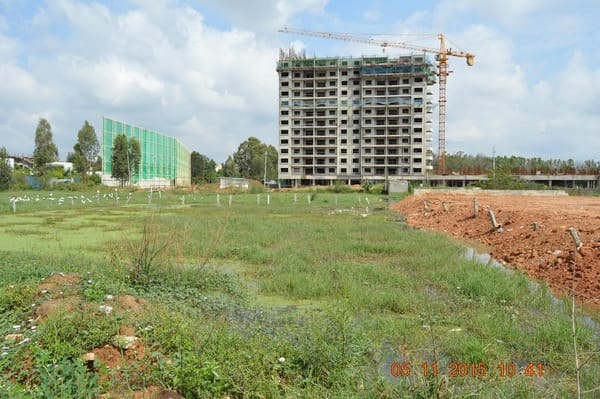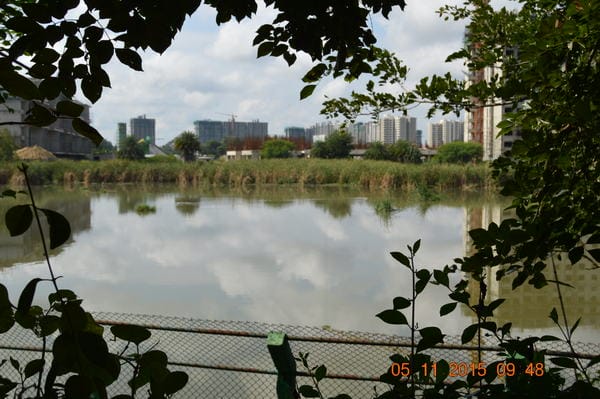Constructions continue unabated in the wetland between Kaikondrahalli and Kasavanahalli lakes. Pic: Adity Roy Nair.
Kaikondrahalli Lake located on Sarjapur Road is a 48-acre urban lung space and water reservoir in the water starved region of Bellandur, Bengaluru. It is also a thriving ecosystem with 50+ species of birds and reptiles. The lake stands as a shining example of the government and the local community working together to preserve an urban common. Kasavanahalli lake, spread over 80 acres, situated upstream was recently rejuvenated. However, this bio-diverse ecosystem is now under immediate threat due to constructions and buffer zone violations on its boundaries.
This is not a one-off occurrence or a first time violation on the lake boundaries. In the past few years, there have been a series of constructions in the valley zone (marked in CDP 2015) between Kaikondrahalli and Kasavanahalli lakes, that pose serious threat to this ecosystem by blocking water inflow and a real danger of flooding to the surrounding areas.
A Google Maps view of the current constructions between the two lakes
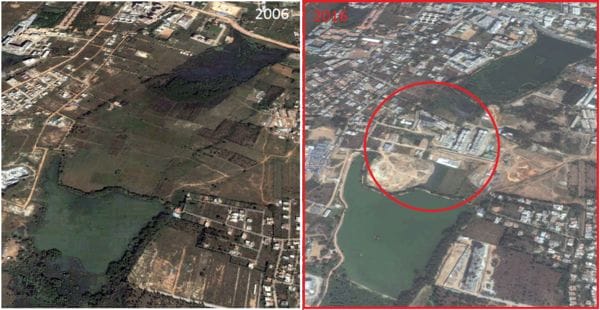
Historical data from Google Earth showing development in the valley zone
Shriram properties – Chirping woods and Bren Imperia are the two largest constructions between the two lakes. The former property has a case of encroachment pending before National Green Tribunal (NGT). In addition, there are smaller constructions and sand dumping around Kasavanahalli lake and the recent constructions at the southern inlet of Kaikondrahalli lake.
As per the buffer zone rules for lakes,
-
There can be no constructions within 100 ft of the lake’s outermost boundary.
-
The natural topography of this zone cannot be altered or constructed upon to allow water catchment and inflow into the lake.
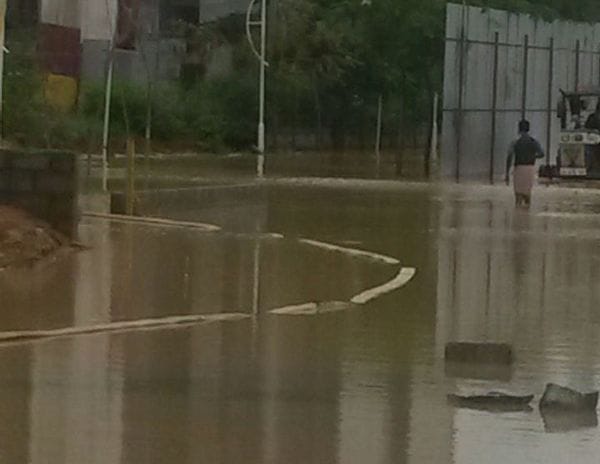
Flooding in 15th main, Shubh Enclave, November 2015. Pic: Adity Roy Nair
Stagnant water between the two lakes. Pic: Adity Roy Nair
Both the conditions are being blatantly violated by many constructions. If continued, such developments in the lake wetlands can lead to irreversible damage and flooding much like the December 2015 Chennai floods. Already the area is seeing the warning signs – constant water and sewage stagnation between the two lakes and a dengue outbreak in the surrounding areas last november as well as heavy flooding during rains. Despite complaints by the surrounding local community, constructions continue unabated sounding a death knell for not only Kasavanahalli / Kaikondrahalli Lakes but also the other downstream lakes in the area.
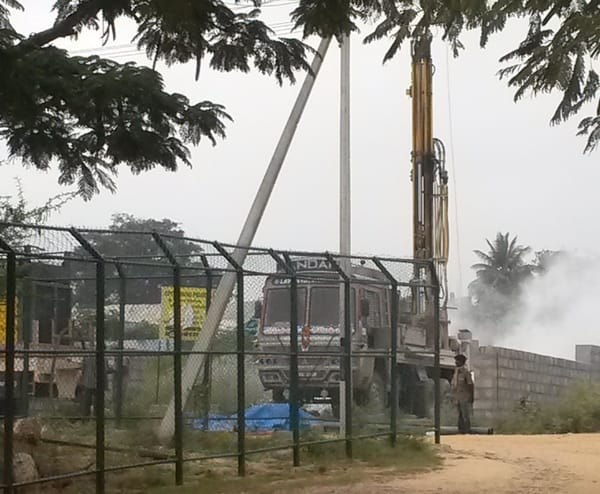
Construction in buffer zone going full steam near Kasavanahalli lake. Pic: Adity Roy Nair
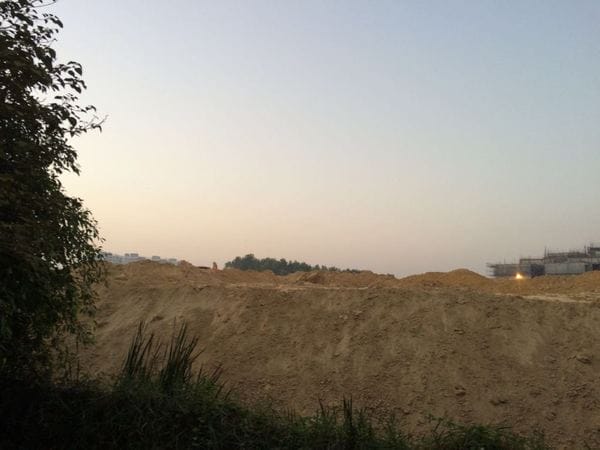
Constructions violating buffer zone at Kaikondrahalli lake. Pic: Vidya Gomathi
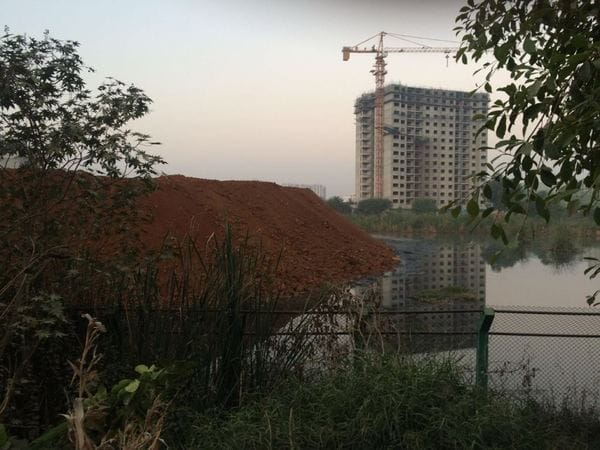
Constructions dump looming many feet higher than Kaikondrahalli lake fence. Pic:Rinaz Mohammed
Sand mining near Kasavanahalli lake. Video: Team Reclaim Bengaluru
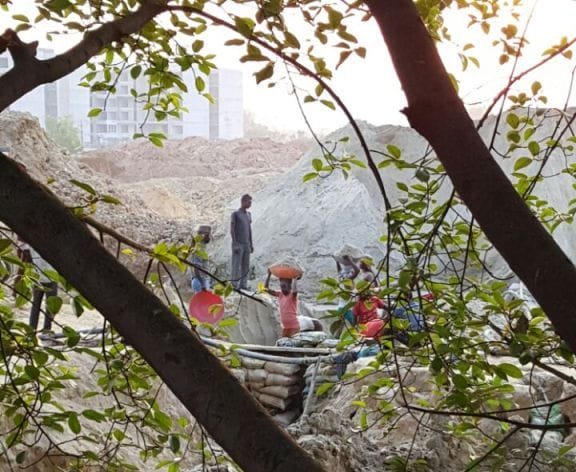
Sand mining near Kasavanahalli lake in progress. Pic: Adity Roy Nair
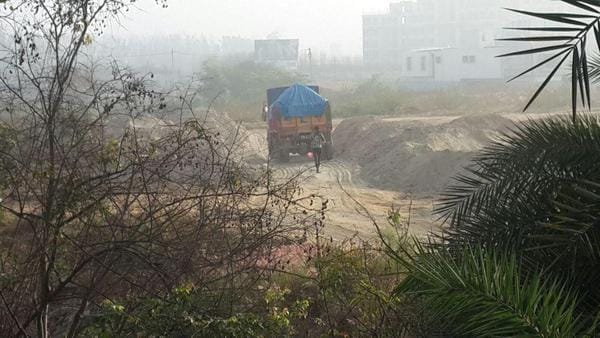
Sand being loaded into trucks. Pic: Adity Roy Nair
The following timeline shows the efforts of the residents during the past two years to bring this to the notice of concerned authorities. Despite continued follow ups, the zonal office has turned a blind eye to the rampant construction and buffer zone violations in the sensitive valley zone between the two lakes.
-
Aug 2014 – Letter to Upalokayukta with copies to BBMP Commissioner, BDA Commissioner, Chief Engineer, Lakes, BBMP Zonal Joint Commissioner, Mahadevapura, regarding actions required to protect buffer zone violations in kasavanahalli lake chain with annexures containing photos.
-
Oct 2014 – Letter to Chief Engineer Lakes, BBMP, highlighting specific issues across many lakes including buffer zone violations at Kasavanahalli lake, with annexures
-
Oct 2014 – Letter to Upalokayukta w.r.t Constructions on sensitive zone between Kaikondrahalli lake and Kasavanahalli Lake
-
April 2015 – E-mail complaint to Upalokayukta judge following Upalokayukta judge Mr. Subhash Adi’s visit to the lake. The owner of sand-filtration site was present when Justice Adi surveyed. Local BBMP and Local Police were asked to serve him notice immediately. Shriram Chirping woods representative also present and Justice Adi warned that blocking of storm water drains and altering of topography can be catastrophic.
-
June 2015 – Chief minister of Karnataka, Shri Siddaramaiah paid a visit to Kaikondrahalli lake along with Shri PC Mohan (our MP), Ramalinga Reddy (Minister in charge of Bangalore, BTM MLA), Krishna Byregowda (Agri minister and Bytarayanapura MLA), Haris (Shantinagar MLA), Arvind Limbavali (Mahadevapura MLA), BWSSB chief Anjum Parvez, DC Harish Naik, Devraj (Mahadevapura JC), EE, AEE, Env Engineer. The CM was made aware of the buffer zone violation issues that the lake was facing.
-
Dec 2015 – Complaint letter to BBMP on “Construction on buffer zone of Kasavanahalli Lake by M/S Dev Infra” submitted by Shubh Enclave. Complaint letter copied to BMTF, Lokayukta, Upa lokayukta, LDA, Tahsildar, TV9 news network. Units of this size do not have it mandatory to construct STPs. So, where does their sewage go?
-
Feb 2016 – Follow up to the letter sent in Dec 2015.
-
March 9th 2016 – Complaint to Karnataka State Pollution Control Board, reporting sand filtering in the buffer zone and apartment construction in between Kasavanahalli lake and Kaikondrahalli lake (marked sensitive/valley zone in CDP 2015, resulting into sewage blockage and overflow. Submitted by Shubh Enclave. Rains in Nov 2015 saw heavy flooding for the first time in this region due to rains.
-
March 15th 2016 – Email complaint to Joint Commissioner BBMP, Mahadevapura, copying PCB Chairman and Chief Engineer Lakes, BBMP, highlighting the buffer zone violation, inlet blockage and fence damage caused by massive construction at the southern tip of Kaikondrahalli lake. Submitted by local residents.
Video of Kasavanahalli lake. Video: Team Reclaim Bengaluru
While cases have been initiated against one of the projects (Shriram Properties Chirping Woods, which is pending before the National Green Tribunal (NGT)), more constructions, dumping and buffer zone violations continue, despite complaints of the local community to BBMP zonal office and Pollution Control Board. Water tables are already low, and will become worse in this area, which has no BWSSB/Cauvery water supply and residents are dependent on tanker water!
The government needs to wake up to the reality of an imminent ecological disaster.
